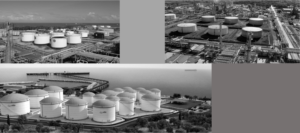Recommissioning Tanks: What Role Does NDT Play? (Part 1)
By: Eng. Jesus Eduardo Contreras
The oil and gas industry experienced some major challenges in 2020. With the sudden reduction in fuel consumption, there was a substantial global surplus of crude oil. This unique situation has seen storage facilities reach maximum capacity and even crude tankers being used to store unwanted product.
Retired storage facilities are being targeted for reinstatement, and operators are considering tank construction to increase capacity. With increased storage requirements and potential inspection deferrals, there is also an increased requirement to perform in-service tank inspection to assess critical components within the asset.
This article will do a complete NDT techniques revision that can be applied to the recommissioning tanks.
An overview of the situation!

Despite their apparent simplicity, many tank components must be inspected. Tank inspection includes assessing the infrastructure of fixed or floating roofs including domes and seals, shell aperture, settlement analysis and strapping. Both internal and external usually take the form of isolated attacks governed by roof geometries, construction methods, plate flatness, and coating conditions. Critical areas involve bottom plates, shell plates, roof plates and all welding joints. While it’s assumed that leakage will occur before a failure, highlighting thin areas of a tank shell, this is not always the case; there may be catastrophic failure without any prior leakage. Monitoring the tank exterior for general metal loss in various areas provides a useful integrity assessment, but the extent of inspection necessary depends on the product stored, tank age, and historical inspection results.
Nowadays, any serious evaluation of an important asset such as a storage tank, goes through a risk-based inspection program (RBI) executed by experienced professionals, which also considers: the product type, historical conditions, construction information and years-in-service.
It is during this initial assessment that knowledge of inspection technology can help make better decisions. The examination is split into a sequence of identified integrity risks, and each component of this inspection can be aided with the correct technology selection.
There are continued advances in new non-destructive testing (NDT) technologies that improve detection of defects and accuracy of sizing. All systems have some limitations and knowing which tool is best for each measurement is important. NDT techniques can be complimentary, and in some cases, they may need to be combined to give the best result. The actual condition of the tank being inspected will also influence measurement accuracy, and this should be considered.
What are the most common techniques used in tank inspection?
- Magnetic Flux Leakage (MFL) and STARS
- Automated and manual Ultrasonics (UT)
- Automated and manual Phased-Array Ultrasonics (PAUT)
- Alternating Current Field Measurement (ACFM®)
- Pulsed Eddy Current (PEC)
- Eddy Current Array (ECA)
- Guided Wave Ultrasonics (GWUT)
Tank floor plates
The most common technology used to inspect bottom plates for corrosion is Magnetic Flux Leakage (MFL) fig.1 because of its sensitivity to corrosion pitting and the ability to inspect nearly 100% of the tank bottom efficiently. Due to the nature of MFL, it is recommended that a percentage of the detected defects are accurately quantified using Ultrasonics (UT), typically with a UT flaw detector. With advances in technology and scanners, phased array (PAUT) fig.2 has become the preferred technique due to its superior ability to categorize and size a type of defect, thus ensuring a more accurate integrity assessment.


Do not miss the second part of this article, we will see another very important group of NDT techniques!




